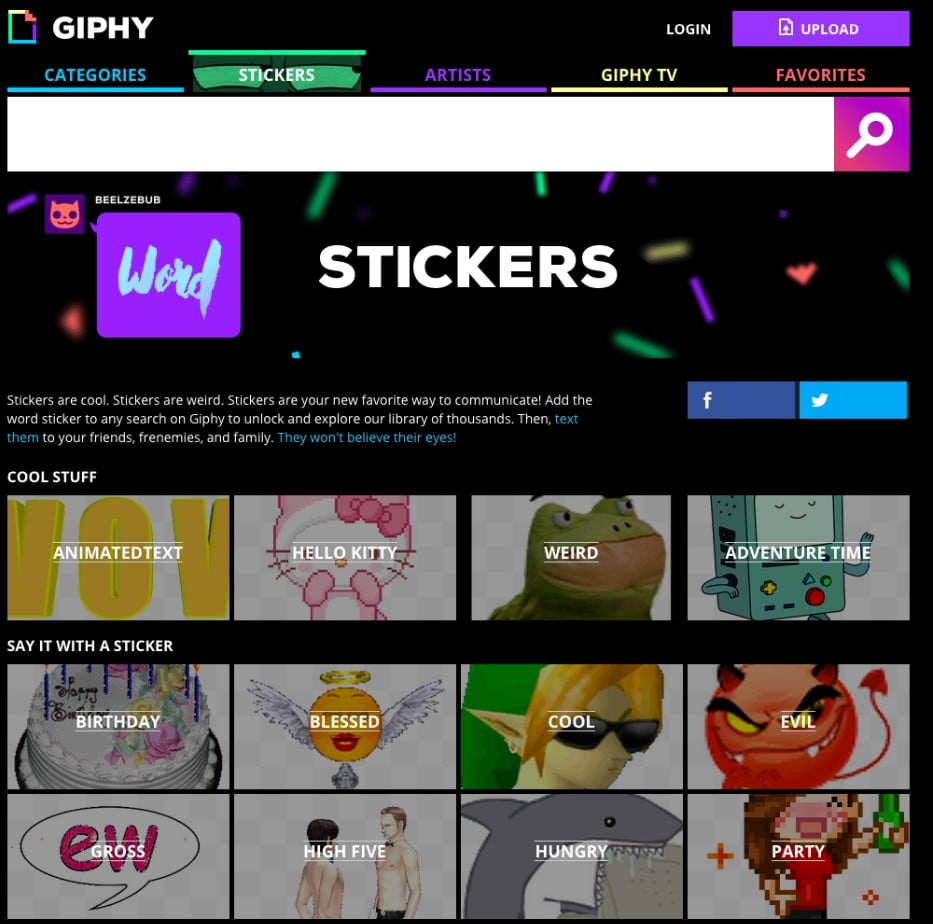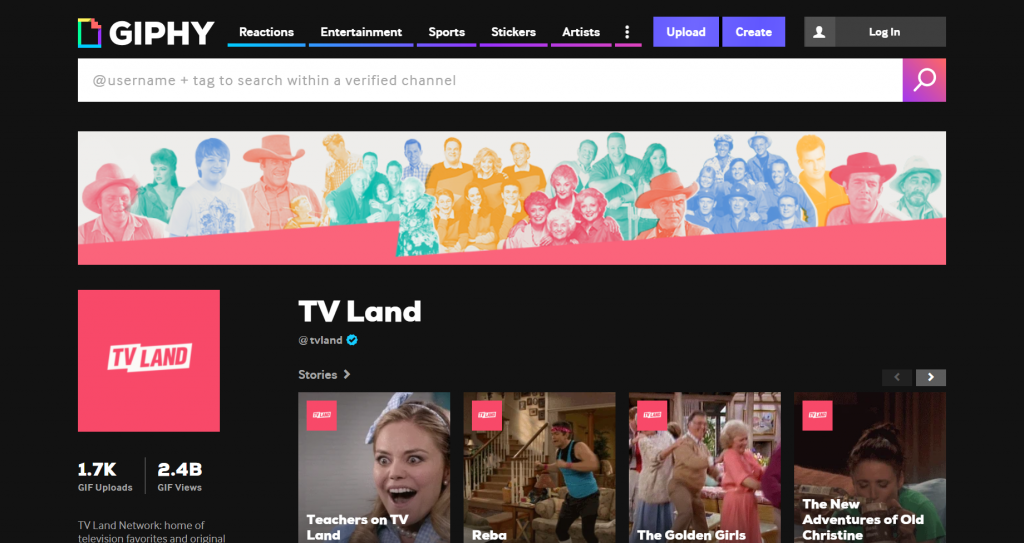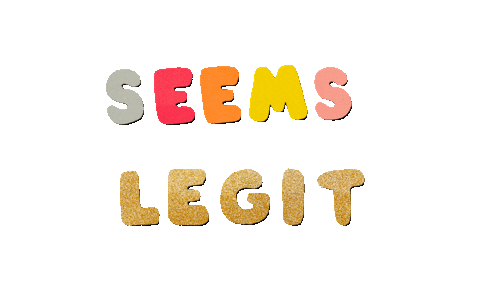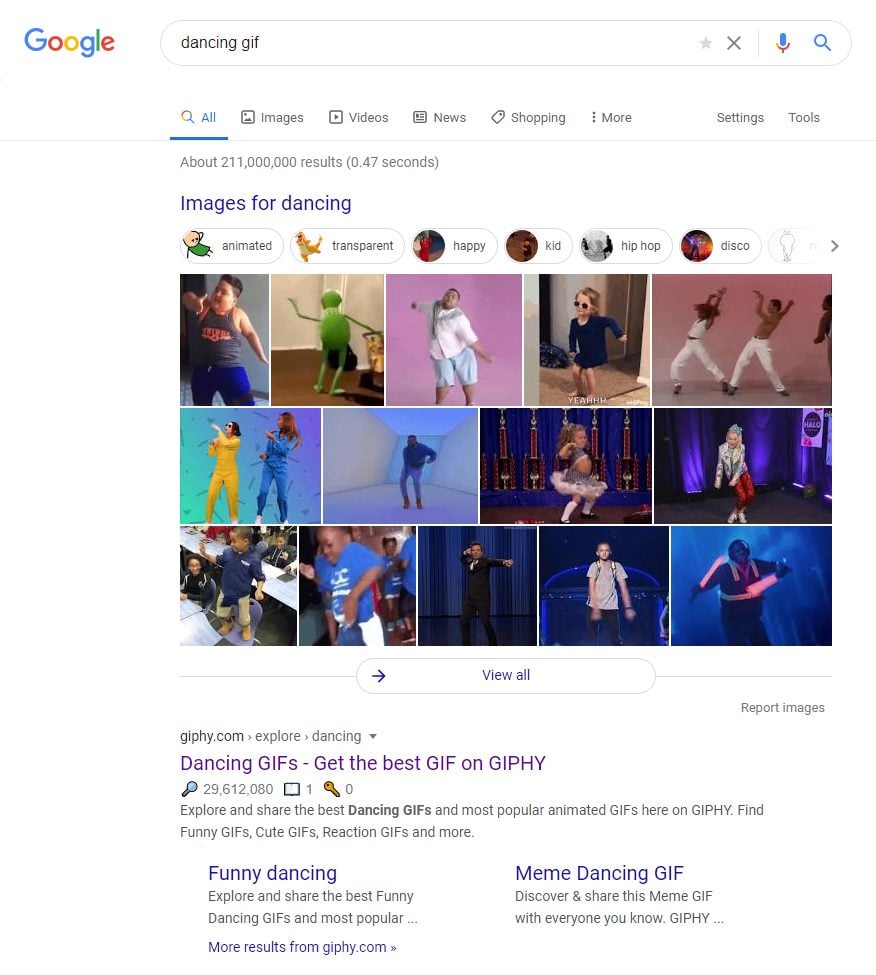You’ll be very wrong to assume what the relevance of GIFs And Giphy is to social media marketing. Whereby, just like emojis, videos, images, and anything other than plain text, both GIFs And Giphy can help add a variety of icing elements to social posts. And, they can often tell a message with a single (animated) picture.
They can make your social media marketing more exciting and entertaining. More than anything, however, your GIFs can appear in specialist search engines that Google, in turn, picks up and uses in its more popular search engine. Although we generally use the terms GIF generically here, there are actually two similar items you can use in your social posts.
Both feature a series of images that, when played in quick succession, look like animation. Technically, GIFS have solid backgrounds. You can also use the very similar things called Stickers in your posts. Stickers have transparent backgrounds. Although almost interchangeable with GIFs from the user’s point of view, the coding is sufficiently quite different.
Particularly, for Giphy to have separate APIs for each type. Unless otherwise stated, we mean both solid background GIFs and transparent background Stickers. More so, when referring to GIFs in this article.
Why Use GIFs And Giphy In Content Marketing
First of all, there’s what we can call a GIF Search Engine. A search engine that returns relevant GIF results. In other words, GIPHY is a GIF search engine serving more than 7 billion GIFs and stickers to 500+ million users every day.
GIPHY powers GIF searches for many messages and social media apps like Facebook, Instagram, TikTok, Twitter, and more. The search engines give brands the chance to create and distribute GIF content to interested users. Every day, GIF search engines serve more than 10 billion GIFs to users.
Across platforms such as Facebook Messenger, WhatsApp, Tinder, iMessage, Slack, and more. More than 70% of people living in the US use emojis, GIFs, and stickers in their daily communications (Harris Poll, 2017). The largest GIF platform — GIPHY — has more than 700 million daily active users.
And, it shares more than 10 billion GIFs every day on the platform. As well as other places where GIPHY is embedded (Variety, 2019). Some brands like Red Bull, Jolly Rancher, Absolut, Benefit Cosmetics, and Gucci, to name a few, have already jumped into marketing partnerships with GIPHY.
GIPHY provides brands with a unique way to boost brand awareness. Not to mention, all you’ll need to do is just create a GIPHY brand channel and upload funny, relevant GIFs featuring your logo or product. We’ll discuss more on that later on.
Power Up Your Social Media Posts With GIFs And Giphy
The casual marketer might not necessarily think about how they can use GIFs to power up their social media posts. Unless you are a regular social user, you might not even think much about GIFs at all. Indeed, you might not even know what a GIF is, what Giphy can do for short animated images, or what YouTube does for videos.
A GIF is a type of animated image. Technically it is just an image file type, just like JPEG and JPG files. The difference between GIFs and those other types is that GIF files can include more than one image, meaning that they can appear like a short animation.
GIFs are not real videos, however. They are a modern version of the old flipbooks – where you show a series of slightly altered images in quick succession. They weren’t designed with animation in mind, but once people saw their potential, that is how animators and marketers started using them.
One of the reasons that GIFs are so popular is that you can use them to convey emotions and ideas. This has made them an integral part of social messaging. And sites like Giphy have made this process extremely simple. All this is great for marketing, helped by the way search engines work.
Utilize Giphy To Create And Organize Your GIFs
Giphy is an incredibly popular source of GIFs. Five hundred million people use 7 billion GIFs obtained from Giphy every day. Giphy has built an API that makes its GIFs available on virtually every social media and messaging app.
Meaning that many people use Giphy GIFs automatically, without thinking about it. Indeed, Giphy has an even wider spread than that. They have indexed virtually every GIF created by anybody anywhere in their search engine.
Even the Influencer Marketing Hub now has a Giphy Money Calculator Tool that will show you the earned media value of a GIF on your Giphy account. Over time, you will notice this value rise for your most popular GIFs – your evergreen content.
How Giphy Can Improve Your Social Media Marketing
Remember the sheer size of Giphy we referred to above. This means that any GIF you create will appear in their search engine. Thanks to the extensive usage of Giphy’s API, your GIFs will also be easily shared and used by people on their social media accounts.
Don’t forget that a GIF includes a series of images that combine to look animated. This means that you can easily add your logo or URL or some other marketing item to your GIFs.
As we mentioned above, GIFs and Stickers are technically different. They have separate Giphy APIs. Facebook, Twitter, Instagram, and WhatsApp use Giphy’s GIF API so that users can easily include GIFS on those platforms. TikTok and Snapchat have included Giphy’s Sticker API instead, so you use Stickers on those platforms.
Although you use GIFs on traditional Instagram, you can also use Stickers on Instagram Stories. According to Giphy’s help files, “a Sticker is a GIF file with transparency around the edges. In order to register as a sticker, at least 20% of pixels must be transparent in the first frame.”
Whether you use GIFs or Stickers, the important thing is to share ones that will attract and interest your intended social audience. Just make sure that you include your logo and URL.
In many ways, GIF marketing is guerrilla marketing. You’re not paying for a billboard, television advert, or, indeed, any advertisement. You aren’t really advertising your products at all. All you need do is create a GIF, and then you can leave it for people to distribute your subtle mini-ad for you.
You don’t even have to try to convince consumers to distribute your marketing material for you – they select and use the GIFs themselves.
You Shouldn’t Underestimate The Search Intent Power Either!
Many businesses devote considerable resources to improving their SEO – search engine optimization – to improve their rankings on Google and the other search engines. In the old days, your focus was entirely on trying to get your web pages and blog posts to rank for key terms that you consider important.
Then Google started featuring images, and firms expanded their SEO to include pictures and other image types. Google has continued to add sections to their search results and complicated the world of SEO. They even started to rank items more at home on social media, including tweets and videos.
In most cases, big companies with powerful websites dominate the search. A few smaller sites can lead search terms in niche fields, but it can be challenging for a smaller business to generate search results anywhere on the front page of Google for popular search terms.
Several companies have set up specialist GIF search engines. These include Tenor and Gfycat, and in particular, Giphy. Giphy and its competitor’s index GIFs by their content, making it very easy to find suitable GIFS to tell a specific message. This gives numerous opportunities for brands to create GIFS that consumers love.
Related Topic: Market Research | How To Do It Better Than Competitors
However, it is much easier for small firms to dominate the Giphy search rankings, and this has a flow-through effect on Google too. You can do this if you create GIFs that match the terms for which your target audience search, particularly as you don’t yet have much competition for GIFs on most topics.
Most of the significant sites that dominate many of the other Google categories haven’t turned their attention to GIFs yet, and you will find it far more competitive. For this to be of value to you, you do need to ensure that your GIFs clearly identify you, preferably using both your logo and URL.
At the very least, you can set up some judicious product placement in your GIFs. But don’t make them appear salesy or anything resembling a traditional ad for your product. Consumers select GIFs to tell a story or send a message. They don’t think of them as an ad.
How To Create A Giphy Branded Channel
While we are focusing on Giphy in this article, you could just as easily use one of the other GIF search engines, such as Tenor or Gfycat. Like Giphy, Tenor has APIs used by all the leading social apps. All the suggestions we make here relating to Giphy could also apply to Tenor or Gfycat.
If you are serious about using Giphy for marketing, then you will want to set up a branded channel there, in much the same way you would on something like YouTube. You begin by setting up an account on Giphy. You can now start to upload GIFs (or Stickers).
Learn More: How To Use GIF Marketing To Boost Brand Awareness
It is essential that you upload at least five GIFs because you need at least that many to be able to have your Giphy channel verified. You can do this if you are a company, recording artist, actor, or public figure with content you’ve created or own. Just a note to agencies, here, however.
Giphy states that if you upload content for your clients, that content will need to be hosted on their channels, rather than your own.

Once Giphy has accepted your application and granted you the verified Giphy brand channel status, you can make your GIFs available across all the social and messaging apps that use either the Giphy GIF or Stickers API.
How To Plan For Your GIF Marketing Schedule
For too long, GIFs have been seen as merely a way to add color to your marketing content. But, did you know that GIPHY, and other GIF search engines like Gfycat and Tenor, have special accounts for brands, agencies, and artists? But why bother with a GIPHY brand account?
As with any other type of SEO, you want to rank for search terms that your target audience is likely to use. Unlike other types of searches, however, it is still much easier to rank for popular GIF searches. This means that you need to consider what terms are likely to be favorites for your target audience.
Ask yourself:
- On what topics are they likely to do searches for GIFs?
- What do you believe will be their most important key terms?
- What are your potential customers talking about?
Search volumes will be lower for GIFs than for text, videos, or more general images. Also, until you have made a big reputation for yourself, people are unlikely to be searching for your business name. Therefore you need to focus more on the types of situations where they are likely to share GIFs.
You’ll then need to create some GIFs on those topics, making sure to include your logo and URL within each GIF. Like all your marketing, you will want to monitor the success of your GIFs and regularly upload new content to your branded channel.
Steps To Use GIPHY Marketing For Brand Awareness
Technically, Giphy provides analytics to help you discover how your GIFS have performed. The Giphy Money Calculator will also give you valuable information about the success of your GIFs.
And, as we’ve mentioned, many big-name brands have already started working with GIPHY to boost their marketing efforts. Well, technically, the first step is to create an account on GIPHY and start uploading GIFs to the platform. Anybody can create an account and upload GIFs.
But, your GIFs won’t show up in search results on third-party social media and messaging apps just like that. Not unless you have a verified brand channel. Below is an illustration of what your brand channel could look like:
Now it’s your turn. Just follow the simple steps to get started with GIPHY marketing for brand awareness. So that you can leverage some of those 10 billion daily GIF impressions.
Step #1: Signup To Create A GIF Brand Channel
Fortunately, signing up for a GIPHY brand channel is easy. Just go here and log in to your GIPHY account (or sign up for a new one). To sign up for a brand channel on GIPHY, you need to have at least 5 GIFs on the platform.
As well as a website, and a social media following. It can take from 2 to 14 days for your brand channel to be approved. Even though, it’s good to note that; during that time, you can continuously build your library of branded GIFs and stickers. Moreover, if you don’t have any GIFs on the platform, you’ll see this page:
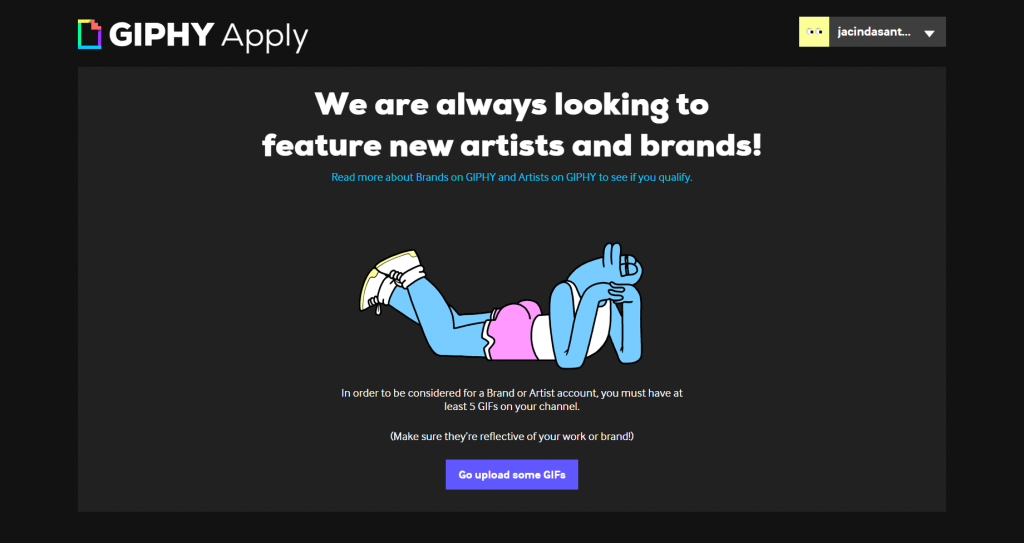
Overall, once you’re verified, your GIFs will be available for use across all platforms that have a GIPHY search engine integration.
Step #2: Target the Right Keywords
Just like any other marketing tactic, you need a strategy for GIF marketing. And, just like many other digital marketing tactics, your GIF marketing strategy starts with keyword research.
Keyword research just means checking out different search terms and topics that are relevant to your brand. So, if you’re a running shoe company like Brooks, you’d want to target keywords like “running shoes women’s,” “tennis shoe,” and other similar keywords.
Adding relevant keywords to your GIFs is important because you want people to find the GIFs that are related to your brand. In addition, you’ll want to tag your GIFs with your brand name and any taglines you use. But what if people aren’t searching for your brand? That’s where your relevant search terms come into play!
Learn More: What Is Keywords Search? A Step-by-step Beginners Guide
These are terms that aren’t necessarily directly related to your brand, but they are related to the types of things your target audience is talking about.
Always remember, when you’re planning out the keywords you want to target, remember that not all keywords are created equal. Some keywords are more competitive than others and, as such, it takes a lot of time, effort, and optimization to rank for those competitive keywords.
If you’re a fast-food brand, for example, you may not be able to rank for a certain number of competitive keywords. Like “fast food,” but you could rank for something like “yum” or “tasty.” Whatever the keywords you choose, it’s important to remember GIPHY’s primary goal: to show users GIFs that are relevant to the keywords they search.
How To Choose Low Competition Keywords:
- Make a list of topics you’re going to target.
- Brainstorm a list of keywords for each of those topics.
- Search GIPHY for each keyword.
- Make note of the number of GIFs as well as the number of views the top GIF has gotten.
From there it’s a bit of a guessing game. Obviously, the keywords that bring up tons of GIFs and where the top GIF has thousands of views are going to be more different to rank.
Step #3: Create Your First GIFs And Giphy
After you have a list of the keywords you’re going to target, it’s time to create content around those terms. There are a few different basic GIF types:
- Animated GIFs: GIFs that add animation to a still image
- Video GIFs: the most common type of GIF
- GIF stickers: typically used as an overlay on an image or video
Animated GIF Example:
An animated GIF is similar to a video GIF, but the GIF is based on a still image that has been animated using animation tools:
Video GIF Example:
Video GIFs feature short video clips:
GIF Sticker Example:
GIF stickers are animated images or text that usually have a transparent background. These are the GIFs that you can put on top of an image or video:
They’re used often on social media platforms like Instagram and Snapchat.
GIF Sticker Using Text Example:
GIFs are exciting and fun. When you’re just getting started using GIFs for marketing, you might want to jump into all the different types. Take a breath and think about where you want these GIFs to do their magic.
If you want to reach users on social media, GIF stickers are the best way to get started. If you don’t know how to edit images or add animations, maybe hold of on animated GIFs for a while. Once you take a minute to think about the platforms and people you’re targeting, it will be easier to decide what type of GIF to create.
Don’t forget to upload your GIFs to your verified brand channel and add your keywords! Once you get your creative ready to go, all you need to do is log in to your verified brand channel, upload your GIFs, and tag each GIF with your target keywords.
Step #3: Optimize Your GIFs And Giphy Brand Channel
GIPHY search results pages are themselves indexed by Google. Here’s what comes up when you search for “dancing gif:”
Notice that the very first result after the image results is from GIPHY.
This gives you a unique opportunity as a brand to turn your GIF marketing into an effective way to boost brand awareness even when people don’t search directly on the GIPHY site. Below are 4 key tips you can use to optimize your GIFs and successfully use GIPHY marketing for brand awareness.
1. Use Relevant Tags:
GIPHY’s search algorithm can’t read images. It relies on the keywords you use when tagging your GIFs to understand a GIF’s context. GIPHY recommends including brand names, the action that’s happening in the image, and proper nouns when you’re adding tags to your GIFs.
This is pretty helpful in terms of keyword research. When you’re searching for relevant tags to add to your GIFs, pay special attention to keywords that are descriptive of the content, used naturally, have a decent search volume, and are relevant to the GIF.
2. Limit the Number of Tags:
Yes, we just told you that you should be using relevant tags for your GIFs and now we’re telling you to limit how many tags you use. Think of your GIF tags as metadata. While you want to include as many relevant search terms as possible, you’re limited with what’s going to actually be able to help you. GIPHY recommends using 10 tags for each GIF and no more than 20.
3. Spy on Your Competitors:
If you’re running out of ideas for ways to tag your GIFs, you need to look no further than your competitors on the platform. This doesn’t necessarily mean your product competitors, though that can give you some amazing ideas, too. What we’re talking about is your topic competitors or those who are competing for other tags that you’re using.
4. Use Popular Branded Keywords:
Typically, people aren’t going to be searching your branded keywords in GIPHY. However, if your brand name and branded keywords get a decent number of monthly searches on Google, you’re going to want to include them on your GIFs.
This could be your exact brand name, variations on your brand name, slogans and taglines, or even keywords related to your brand culture. Take a look at your social media to see how followers are engaging with you there. Are there keywords they’re using that you could incorporate into your GIF marketing strategy?
Step #4: Track Your GIPHY Marketing Performance
GIFs are evergreen content, meaning they’re always relevant. That also means you’ll want to regularly monitor the performance of your GIFs. With a verified brand channel on GIPHY, you’ll get access to the analytics dashboard. On your analytics dashboard, you’ll be able to see view counts for your GIFs. Here’s how GIPHY defines what a view count is:
“A single view is counted when a GIF is served, regardless of how many times it loops. A GIF view on GIPHY is a sign of relevance, share-ability, and popularity.”
This will help you understand the types of GIFs and GIF content that perform the best for the audience you’re trying to reach. That way, you can model other GIFs on what works.
To calculate the organic CPM (cost-per-thousand impressions) of your GIFs, you only need to compare the cost of creating the GIF to the number of impressions the GIF has received.
If you spent $1,000 to create a GIF that has generated 5 million impressions, your CPM would be $0.20.
Takeaway,
You may not have considered using GIPHY marketing for brand awareness until a few minutes ago, but that doesn’t mean it’s too late to start. GIF marketing is a fantastic opportunity to get your brand in front of millions of people every single day. And, you can use what you already know about marketing to create a solid GIF marketing strategy.
GIFs offer a fun and fresh approach to marketing. So, have fun with it! But, if you’ll need more support, you can always Consult Us and let us know how we can sort you. Our team of Web Tech Experts is more than glad to come in handy.

